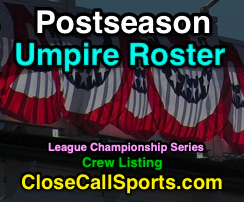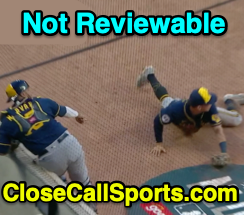Friday, October 15, 2021
2021 AL & NL Championship Series Umpire Roster
Major League Baseball assigned 14 umpires to the 2021 American and National League Championship Series round of MLB's postseason, with crew chief Bill Miller working the ALCS and Jerry Meals presiding over the NLCS. The 7th umpire assigned to each crew will serve in a reserve or standby capacity and not travel to/from Replay Review during the postseason. Instead, the umpire rotation shall be as follows: Game 1: HP; Game 2: RF; Game 3: LF; Game 4: 3B; Game 5: 2B; Game 6: 1B; Game 7: Reserve/Off.
Crew Chiefs are indicated in bold text and by the -cc suffix with regular season crew chiefs denoted by an asterisk (*) while those working their first League Championship Series will be noted with a ^ mark.
AL Lg Championship Series (Boston Red Sox @ Houston Astros) Umpires:
HP: David Rackley^
1B: Bill Miller* -cc [Game 3 Plate]
2B: Laz Diaz [Game 4 Plate]
3B: Dan Iassogna* [Game 5 Plate]
LF: Jim Wolf [Game 6 Plate]
RF: Alan Porter [Game 7 Plate]
Reserve/Off: Rob Drake [Game 2 Plate]
NL Lg Championship Series (Los Angeles Dodgers @ Atlanta Braves) Umpires:
HP: Tripp Gibson^
1B: Jerry Meals* -cc [Game 3 Plate]
2B: James Hoye [Game 4 Plate]
3B: Mark Carlson* [Game 5 Plate]
LF: Lance Barksdale [Game 6 Plate]
RF: Todd Tichenor [Game 7 Plate]
Reserve/Off: Jordan Baker^ [Game 2 Plate]
Replay Review: Cory Blaser, Marvin Hudson, Nic Lentz.
Labels:
News
,
Rosters
,
UEFL
,
Umpire Odds/Ends
Thursday, October 14, 2021
Discussion of 2021 AL and NL Division Series
Join us for discussion of the 2021 American and National League Division Series: As we have done in the past, we will post UEFL f/x plate scores for every home plate umpire this postseason.
Performance plate scores are listed following the completion of each contest according to UEFL f/x (StatCast data and application of UEFL Rules 6-2-b-a [horizontal bound, "Kulpa Rule"] and 6-2-b-b [vertical strike zone, "Miller Rule"]) for called strikes and balls. Foul balls, swinging strikes, balls put in play, automatic balls, pitchouts, and hit-by-pitches are excluded from the analysis. Click here to learn how UEFL f/x 3.0 plate scores work.
- 10/7 CWS@HOU Gm 1: Adam Hamari. 112/114 Balls + 42/51 Strikes = 154/165 = 93.3%. +1 HOU.
- 10/7 BOS@TB Gm 1: Dan Bellino. 90/95 Balls + 44/45 Strikes = 134/140 = 95.7%. +2 TB.
- 10/8 CWS@HOU Gm 2: Chris Conroy. 100/101 Balls + 43/44 Strikes = 143/145 = 98.6%. +0 Neutral.
- 10/8 ATL@MIL Gm 1: Mike Estabrook. 87/90 Balls + 32/35 Strikes = 119/125 = 95.2%. +2 MIL.
- 10/8 BOS@TB Gm 2: DJ Reyburn. 108/108 Balls + 46/49 Strikes = 154/157 = 98.1%. +3 BOS.
- 10/8 LAD@SF Gm 1: Carlos Torres. 69/70 Balls + 37/41 Strikes = 106/111 = 95.5%. +5 SF.
- 10/9 ATL@MIL Gm 2: Mike Muchlinski. 92/93 Balls + 49/53 Strikes = 141/146 = 96.6%. +1 MIL.
- 10/9 LAD@SF Gm 2: Angel Hernandez. 87/88 Balls + 41/46 Strikes = 128/134 = 95.5%. +0 Neutral.
- 10/10 TB@BOS Gm 3: Sam Holbrook. 116/120 Balls + 49/54 Strikes = 165/174 = 94.8%. +1 BOS.
- 10/10 HOU@CWS Gm 3: Tom Hallion. 134/139 Balls + 42/51 Strikes = 176/190 = 92.6%. +4 CWS.
- 10/11 MIL@ATL Gm 3: Alfonso Marquez. 90/91 Balls + 37/40 Strikes = 127/131 = 96.9%. +4 MIL.
- 10/11 TB@BOS Gm 4: Ron Kulpa. 73/75 Balls + 31/35 Strikes = 104/110 = 94.5%. +2 BOS.
- 10/11 SF@LAD Gm 3: Ted Barrett. 84/85 Balls + 39/46 Strikes = 123/131 = 93.9%. +4 LAD.
- 10/12 CWS@HOU Gm 4: Vic Carapazza. 117/120 Balls + 57/59 Strikes = 174/179 = 97.2%. +1 CWS.
- 10/12 MIL@ATL Gm 4: Tony Randazzo. 94/98 Balls + 46/50 Strikes = 140/148 = 94.6%. +2 ATL.
- 10/12 SF@LAD Gm 4: Pat Hoberg. 101/103 Balls + 41/42 Strikes = 142/145 = 97.9%. +1 LAD.
- 10/14 LAD@SF Gm 5: Doug Eddings. 86/87 Balls + 43/45 Strikes = 129/132 = 97.7%. +1 LAD.
Note: The highest plate score during the 2020 Division Series was Todd Tichenor's 98.0% (ALDS 4).
The highest overall plate score during the 2020 Postseason was Hoberg/Hudson/Miller's 98.7% (WC/WS).
Wednesday, October 13, 2021
Brewers-Braves NLDS & Replay's Infield Fly Limitation
In Game 4 of the #Brewers-#Braves National League Division Series, umpires conducted a rules check on Adam Duvall's foul fly ball to Milwaukee third baseman Luis Urias behind home plate, deflected by catcher Omar Narvaez. The only problem? The play was unreviewable thanks to MLB's long-standing replay rules.
Ever since baseball first released its Replay Review Regulations in 2014, the question of what is and isn't reviewable has been a point of contention. While certain plays—pitchers intentionally throwing at batters or certain interference/obstruction calls—wisely are excluded from replay eligibility, there are others that are a little more curious. One of those? Fly balls in the infield.
Related Post: Tmac's Teachable Moments - Let's Fix Replay (1/19/17).
Accordingly, as soon as Duvall's foul fly resulted in a diving catch by the glove of Urias, we knew that HP Umpire Tony Randazzo's out call would be unreviewable. And although the play occurred in the general vicinity of the screen behind home plate, we also knew it was nowhere near close enough to trigger a stadium boundary review.
Based on Crew Chief Alfonso Marquez's mechanics (which was to give no signal after removing the headsets to NY), it is quite apparent this play was not formally reviewed: the rules check simply established that Braves manager Brian Snitker's attempt to challenge the catch/no catch call was not a reviewable element of the play, even if the pop fly itself was high enough in the air that it was not one of those catch/no catch bullets hit down the first or third base line that Bud Selig made reference to in 2012. As the game evolves so too must replay.
Related Post: Bud Selig: MLB Expanded Replay Reluctantly on the Way (7/27/12).
Which returns us to our 2017 instant replay argument: let's make more things reviewable.
Video as follows:
Video as follows:
Labels:
Articles
,
Ask the UEFL
,
Instant Replay
,
UEFL
,
Umpire Odds/Ends
,
Video Analysis
Sunday, October 10, 2021
Sorry, Stros - RLI Doesn't Apply on Plays FROM First Base
When Astros first baseman Yuli Gurriel's thrown ball toward home plate hit White Sox batter-runner Yasmani Grandal on the infield grass, Houston sought a runner's lane interference call, but HP Umpire Tom Hallion said the 45-foot line didn't matter for this play. Why is that?
With none out and runners at the corners in the 4th inning of Sunday's Houston-Chicago ALDS Game 3, White Sox batter Grandal hit a 0-1 changeup from Astros pitcher Zack Greinke on the ground to first baseman Gurriel, who threw home to make a play on White Sox baserunner R3 Luis Robert. Gurriel's throw hit Grandal and deflected past catcher Martin Maldonado, allowing Robert to score and runner R1 Jose Abreu to advance to third base.
After the play, Houston campaigned for a call, but after conference, the umpires opted not to rule Grandal out for interference. There are two kinds of interference that came up in Hallion's subsequent discussion with Houston manager Dusty Baker.
The first is runner's lane interference, or Official Baseball Rule 5.09(a)(11), which states, in part, "In running the last half of the distance from home base to first base, while the ball is being fielded to first base," the runner isn't within the lane, etc. I stopped after the first phrase because we already have our answer as to why RLI doesn't apply: the ball was not "being field TO first base": it was being thrown FROM first base. That's how simple it is to explain why RLI, and thus the runner's lane itself, doesn't matter here. You'll recall every time we've discussed RLI, it's been on a play TO first base, and now you know why.
As for interference with a thrown ball, OBR 6.01(a)(10) states that a runner can be declared out for two reasons: "fails to avoid a fielder who is attempting to field a batted ball, or intentionally interferes with a thrown ball." Just like RLI, the rule gives us our answer. This is not a batted ball, but a thrown ball, which means the interference must be intentional. Simply running on the grass or otherwise is not on its own sufficient to establish this level of intent—Hallion gave an elbow/chicken wing gesture while talking with Baker to demonstrate what would signify intent—and for that reason, umpires declined to call interference.
Finally, as we have stated many times over the years, the baseline is irrelevant here and the base path three-foot rule also does not apply because the base path rule only applies when a fielder is attempting to tag the runner.
Video as follows:
Video as follows:
Labels:
Articles
,
Ask the UEFL
,
Interference
,
Rule 2.00 [Interference]
,
Rule 5.09
,
Rule 6.01
,
Runner's Lane Interference
,
Tom Hallion
,
UEFL
,
Umpire Odds/Ends
,
Video Analysis
Rays Lose Run, Game After Batted Ball Deflection Rule
Tampa Bay lost a run, then the game, in the 13th inning against Boston during Game 3 of the Rays-Red Sox ALDS when batter Kevin Kiermaier's fly ball to left-center field deflected off BoSox outfielder Hunter Renfroe and over the wall. Did umpires get the call right, by rule? Especially given that Rays baserunner R1 Yandy Diaz appeared poised to score as the ball left the playing field on the deflection...
To recap, with two out and one on (R1) in the top of the 13th, Rays batter Kiermaier hit a 3-2 slider from Red Sox pitcher Nick Pavetta to deep right-center field, where the batted ball hit the outfield wall and then the dirt warning track before bouncing into outfielder Renfroe, after which the ball deflected over the wall and out of play. Initially ruled a two-base award by RF Umpire DJ Reyburn, Crew Chief Sam Holbrook signaled affirmation of the call following a Replay Review.
The relevant rule is Official Baseball Rule 5.06(b)(4)(H) and its corresponding MLB Umpire Manual Interpretation, which describes this precise scenario: "If a fair ball not in flight is deflected by a fielder and then goes out of play, the award is two bases from the time of the pitch."
There you have it: it's a two-base award from time of pitch ("TOP")—no umpire discretion as to runner placement. As soon as the umpires determine the fair ball not in flight was deflected by a fielder out of play, the award must be two bases from TOP—R1 Diaz to third and BR Kiermaier to second. Tough break for Tampa Bay (especially when Boston's Christian Vazquez hit a walk-off home run in the bottom of the frame).
A somewhat (but not exactly) similar play occurred at Fenway Park at the same short outfield wall in front of the left field bullpen back in 2019 as Boston defeated Cleveland. During that game, Boston batter JD Martinez hit a fly ball that first struck the wall before rebounding onto Indians outfielder Oscar Mercado, then deflecting out of play into the fair-territory bullpen.
Related Post: Case Play 2019-2 - Fly Ball off Player & Wall [Solved] (6/2/19).
And, for good measure, in July 2019, Rays left fielder Tommy Pham deflected Blue Jays batter Freddy Galvis' not-in-flight fly ball into the stands, resulting in a two bases-from-TOP award. The rule, which oddly enough affected both Boston and Tampa Bay in 2019, continues to prescribe a two-base award without further runner placement consideration.
Labels:
Articles
,
Ask the UEFL
,
Rule 5.06
,
Rules Review
,
UEFL
,
Umpire Odds/Ends
,
Video Analysis
Subscribe to:
Posts
(
Atom
)



















